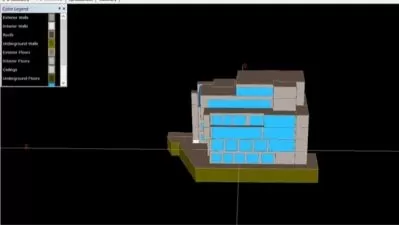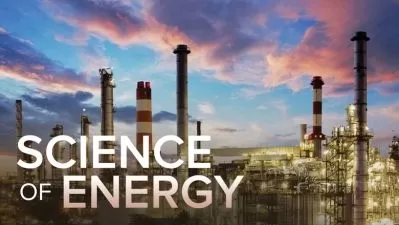Process of Undertaking a Successful Energy Audit
Bruce Rowse
3:11:55
Description
A Comprehensive Guide to a Successful Energy Audit
What You'll Learn?
- A comprehensive process for successfully undertaking an energy audit
- A thorough process that can be used to deliver an Investment Grade Audit (IGA) or Detailed Feasibility Study (DFS)
- What you need to do before the audit to keep everyone happy
- How to ensure that your estimates of savings are realistic
- Six principles for a successful audit
- How to present your findings in a way that maximizes the chance your recommendations will be implemented
Who is this for?
What You Need to Know?
More details
DescriptionIndustrial and Commercial Energy Audit Process Course
Energy managers and others interested in or who are implementing ISO 50001 Energy Management Systems will find this course useful for understanding how to undertake a comprehensive energy review. It is also well suited to those who would like to undertake ISO 50002 adherent energy audits, and who need to understand what are the practical steps involved in undertaking an energy audit.
This Commercial Energy Audit Process Course is for those undertaking energy audits of commercial and industrial facilities, not applicable for residential energy audits. This course aims to provide you with a proven-effective process that may help you meet the intent of each energy audit standard.
Although our Process of Undertaking a Successful Energy Audit course does not specify calculations for savings measures, it does show you a thorough process to follow for undertaking these calculations.
Unlock the secrets to a successful energy audit that delivers results.
Master a comprehensive process for conducting energy audits with confidence.
Learn how to keep all stakeholders happy by preparing effectively.
Discover the six principles that pave the way for a truly successful audit.
Process of Undertaking a Successful Energy Audit Description
Energy audits can play a crucial role in ensuring that investments to improve the efficiency of existing facilities are effective. Around the world, governments encourage, support, and mandate the undertaking of energy audits.
Unfortunately, many audits are not undertaken successfully. In fact, an evaluation of several hundred energy audits of commercial and industrial facilities undertaken in recent years in Victoria, Australia, found that roughly only 50% of the audits were successful.
In this Commercial Energy Audit Process Course, you’ll learn a comprehensive process for successfully undertaking an energy audit. You can apply this process to deliver an Investment Grade Audit (IGA) or Detailed Feasibility Study (DFS).
Why and How This Course Has Been Developed
We developed this Commercial Energy Audit Process Course because far too many energy audits have low implementation rates, fail to thoroughly investigate all savings opportunities, and costs and savings are sometimes poorly estimated.
Your instructor is an energy auditor with more than two decades of experience and has undertaken energy audits, including IGAs/DFSs of hundreds of facilities:
Offices
Schools
Hotels
Hospitals
Restaurants
Municipal buildings
Factories
Food manufacturers
Chemical manufacturers
Primary producers
He has assisted energy users achieve measured reductions in their energy use of up to 80%.
Who this course is for:
- For those undertaking energy audits of commercial and industrial facilities (it is not a course for home energy audits), in any country
- For anyone who already undertakes energy audits, or for someone who already undertakes energy audits
- If you are new to energy auditing, or have only done a few audits, undertaking this course should save you a great deal of effort and learning by trial and error
Industrial and Commercial Energy Audit Process Course
Energy managers and others interested in or who are implementing ISO 50001 Energy Management Systems will find this course useful for understanding how to undertake a comprehensive energy review. It is also well suited to those who would like to undertake ISO 50002 adherent energy audits, and who need to understand what are the practical steps involved in undertaking an energy audit.
This Commercial Energy Audit Process Course is for those undertaking energy audits of commercial and industrial facilities, not applicable for residential energy audits. This course aims to provide you with a proven-effective process that may help you meet the intent of each energy audit standard.
Although our Process of Undertaking a Successful Energy Audit course does not specify calculations for savings measures, it does show you a thorough process to follow for undertaking these calculations.
Unlock the secrets to a successful energy audit that delivers results.
Master a comprehensive process for conducting energy audits with confidence.
Learn how to keep all stakeholders happy by preparing effectively.
Discover the six principles that pave the way for a truly successful audit.
Process of Undertaking a Successful Energy Audit Description
Energy audits can play a crucial role in ensuring that investments to improve the efficiency of existing facilities are effective. Around the world, governments encourage, support, and mandate the undertaking of energy audits.
Unfortunately, many audits are not undertaken successfully. In fact, an evaluation of several hundred energy audits of commercial and industrial facilities undertaken in recent years in Victoria, Australia, found that roughly only 50% of the audits were successful.
In this Commercial Energy Audit Process Course, you’ll learn a comprehensive process for successfully undertaking an energy audit. You can apply this process to deliver an Investment Grade Audit (IGA) or Detailed Feasibility Study (DFS).
Why and How This Course Has Been Developed
We developed this Commercial Energy Audit Process Course because far too many energy audits have low implementation rates, fail to thoroughly investigate all savings opportunities, and costs and savings are sometimes poorly estimated.
Your instructor is an energy auditor with more than two decades of experience and has undertaken energy audits, including IGAs/DFSs of hundreds of facilities:
Offices
Schools
Hotels
Hospitals
Restaurants
Municipal buildings
Factories
Food manufacturers
Chemical manufacturers
Primary producers
He has assisted energy users achieve measured reductions in their energy use of up to 80%.
Who this course is for:
- For those undertaking energy audits of commercial and industrial facilities (it is not a course for home energy audits), in any country
- For anyone who already undertakes energy audits, or for someone who already undertakes energy audits
- If you are new to energy auditing, or have only done a few audits, undertaking this course should save you a great deal of effort and learning by trial and error
User Reviews
Rating
Bruce Rowse
Instructor's Courses
Udemy
View courses Udemy- language english
- Training sessions 40
- duration 3:11:55
- Release Date 2024/04/14











